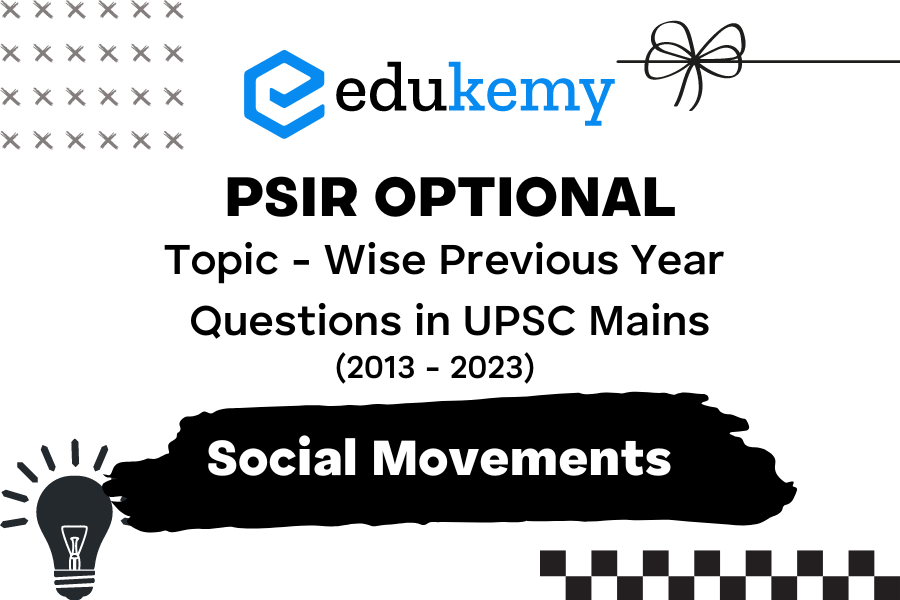
Embarking on the challenging journey of cracking the UPSC Mains examination requires a strategic and comprehensive approach, especially when it comes to choosing optional subjects. Among the array of choices, Political Science and International Relations (PSIR) has consistently held its ground as a popular option. In particular, the Social Movements section within the PSIR syllabus serves as a critical area of study, shedding light on the dynamic forces shaping societies and political landscapes. Aspirants often seek a roadmap to success, and what better way to navigate the PSIR optional than by delving into the previous year questions. In this blog series, we’ll unravel the intricacies of the PSIR Optional Topic – Social Movements, focusing on the questions asked from 2013 to 2023 in the UPSC Mains examination. By dissecting these questions, we aim to provide invaluable insights, strategic tips, and a nuanced understanding of the subject to empower UPSC aspirants in their pursuit of excellence.
As we embark on this exploration, it’s crucial to recognize the significance of Social Movements within the PSIR optional. This section goes beyond the theoretical frameworks and textbooks, delving into the real-world dynamics of collective actions, protests, and societal changes. The UPSC Mains, being a test of analytical and application skills, often challenges candidates to apply their theoretical knowledge to contemporary issues. The Social Movements questions, spanning a decade, not only reflect the evolving nature of societal challenges but also test candidates on their ability to critically analyze, contextualize, and offer nuanced perspectives. Through this series, we aim to equip UPSC aspirants with the tools they need to navigate the Social Movements section successfully, unraveling the patterns, themes, and expectations laid out by the UPSC over the years.
Contents
- 1 Social Movements – Previous Year Questions (UPSC CSE Mains PSIR Optional)
- 2 Frequently Asked Questions (FAQs)
- 2.1 Q: What defines a social movement, and how does it differ from other forms of collective action?
- 2.2 Q: What are the key factors that contribute to the emergence of social movements?
- 2.3 Q: How do social movements leverage media and technology to achieve their objectives?
- 2.4 Q: What role do social movements play in influencing policy changes?
- 2.5 Q: How do social movements adapt to changing socio-political landscapes over time?
- 3 In case you still have your doubts, contact us on 9811333901.
Social Movements – Previous Year Questions (UPSC CSE Mains PSIR Optional)
Civil liberties and human rights movements; women’s movements; environmentalist movements.
1. Comment: Women empowerment in India and its impact on democracy. (2000)
2. The women activists did not support Quota till 1974. What led to the subsequent change in their stand? (2001)
3. Comment: The Concept of Women Empowerment. (2006)
4. “The environmental movements have challenged the policy and pattern of economic development in post – independent India.” Analyse with examples. (2009)
5. Discuss the impact of environmentalist movements on government policies in recent years. (2012)
6. Comment in 150 words: Compare and contrast Chipko Movement with Narmada Bachao Andolan. (2013)
7. Comment in 150 words: The dilemmas of the human rights movements in India. (2014)
8. Examine the scope and limitations of women’s movements in India. (2014)
9. Discuss the Right to information and underline challenges being posed before it. (2016)
10. Critically analyse the environmentalist movement in Tuticorin, Tamilnadu. (2018)
11. Write short note on significance of the Chipko Movement. (2019)
12. Examine the nature of, the civil liberty movement in India. (2020)
13. The making of the Indian Constitution is described as an attempt towards ‘social revolution’. Comment.(2022)
Frequently Asked Questions (FAQs)
Answer: A social movement is a collective, organized effort by a group of people to bring about social change or address a particular issue. Unlike sporadic protests or demonstrations, social movements often involve sustained, coordinated actions aimed at influencing public opinion or policy decisions.
Answer: Social movements typically arise in response to perceived injustices, inequalities, or societal issues. Factors such as economic disparities, political repression, cultural shifts, or technological advancements can serve as catalysts, mobilizing individuals to join together for a common cause.
Answer: In the contemporary landscape, social movements harness the power of media and technology to amplify their messages and reach a broader audience. Platforms like social media enable rapid dissemination of information, organization of events, and the creation of online communities, fostering both local and global solidarity.
Answer: Social movements exert influence on policymaking through various channels, including public awareness campaigns, lobbying efforts, and direct engagement with policymakers. By mobilizing public support, social movements can sway public opinion and compel policymakers to address the concerns raised by the movement.
Answer: Social movements are dynamic entities that evolve in response to shifting societal conditions. Adaptability is crucial for their longevity and effectiveness. Successful movements often adjust their strategies, embrace new technologies, and incorporate lessons learned from past experiences to remain relevant and impactful in the face of changing socio-political landscapes.
In case you still have your doubts, contact us on 9811333901.
For UPSC Prelims Resources, Click here
For Daily Updates and Study Material:
Join our Telegram Channel – Edukemy for IAS
- 1. Learn through Videos – here
- 2. Be Exam Ready by Practicing Daily MCQs – here
- 3. Daily Newsletter – Get all your Current Affairs Covered – here
- 4. Mains Answer Writing Practice – here

